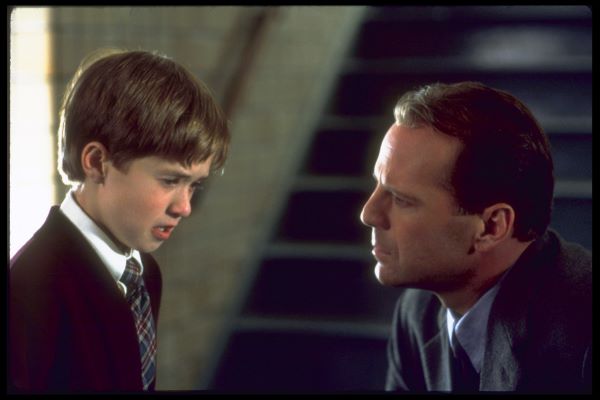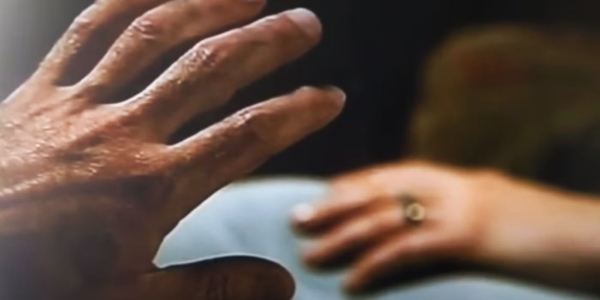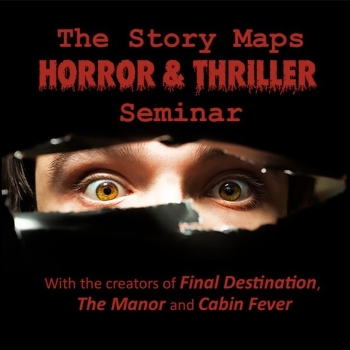‘Yes, And’-ing Your Story: The Sixth Sense by Daniel Calvisi
Let’s do some more “Yes, and’ing” of movie stories, shall we? This time, I’ve looked at a screenplay that I originally covered on the job as a professional Reader, then watched it sell in a huge $3+ million deal for M. Night Shyamalan to write and direct the film that not only went on to become a huge hit, but at the time it became the biggest horror film to date and even broke into the top ten of biggest box-office hits in history (not adjusted for inflation). You know it, you love it.
The Sixth Sense.
Its success is still astounding, considering it’s essentially a quiet, character-driven family drama with no CGI or graphic violence. It was produced on a medium budget and basically shot like a TV movie. It wasn’t production values, big set pieces or outrageous jump scares that made this film a phenomenon, it was the story.
I do this “concept stacking” exercise to highlight how talented writers develop their premises and add unique details that give life to their worlds and add muscle to their characters. In these examples, I’m doing it after-the-fact, so it’s not revealing the actual process used by the writer or the order in which they discovered elements in the story, but rather it’s a hypothetical exercise that shows you how you might go about developing your original concept. You open your mind and let it drift, firing your creative synapses without limitation, but while challenging yourself to add new details that feel fresh and, ideally, create conflict. It’s pretty easy to do; also, it’s fun.
Everyone likes pizza, right? If the commercial movie business wants a pizza (aka a film) that is “the same but different,” a unique riff on familiar and classic archetypes, then doing the “Yes, and” exercise can help you find the most unique, artisan toppings to put on your pizza pie, rather than just settling for boring old pepperoni or sausage. As a pro reader, I was always longing for new bits of business to surprise me, new ways of viewing a familiar character or story engine that I’d not seen before.
Let’s dive in. I’m going to start with the assumption that Shyamalan began with only the idea of a boy who could see ghosts. I don’t know if that was indeed the case, it’s just a good place to start, also it’s worth noting that this wasn’t a unique character archetype by any means – Danny Torrance in The Shining could be considered just one previous iteration. It wasn’t enough to just have a child who communed with the dead, there had to be more to it.
As for the adult protagonist, Shyamalan has said that he didn’t figure out that Malcolm Crowe (Bruce Willis) was dead until the fifth draft of the script. That’s right—the most famous part of a really famous film was not there at the dawn of the idea. It was found through a process of discovery over a span of drafts. There’s no stopping you from doing the same thing. Here goes…
This is the story of a boy who sees ghosts.
Yes, and he can’t tell anyone about his power because he knows they’ll think he’s a freak. He’s already bullied at school and the kids think he’s weird. He has no real friends.
Yes, so he keeps this secret from everyone, including his family.
Yes, but to highlight how alone he is, he only has one family member, a single mother.
Yes, and she worries about him because she sees him talking to no one like he’s hearing voices from somewhere, and she sees odd occurrences around the house.
Yes, like she leaves a room and then walks back into it and something’s impossibly changed, like all of the cabinet doors are open in the kitchen, but her boy is still sitting in the same position and hasn’t moved.
Yes, and the kid gets in trouble at school because he tells the teacher that they used to hang people on the school grounds because he could see dead bodies hanging from nooses.
Yes, so his mother takes him to a child psychologist.
Yes, and the child psychologist is also a troubled guy. He had another kid client who died or something.
Yes, his former young client told him he was hearing voices, but he didn’t believe him.
Yes, and his failure with that kid led to the end of his marriage.
Yes, maybe the kid committed suicide, and the psychologist went into a depression.
Or more extreme – the kid broke into their house and shot the wife.
That’s maybe a bit too far, also if we kill off the wife then she can’t be a character in the story.
Okay, so what if the troubled kid shot the psychologist, and he lived, but the shock of the horrible act devastated the marriage, so now they’re separated?
Yes, now back to our current kid who sees ghosts, he meets our psychologist and doesn’t trust him at first, but he slowly comes around and feels safe around him.
Yes, and eventually he tells the psychologist that he can see the dead. This is why he’s always so filled with anxiety and dread. The ghosts scare him. He doesn’t know why they plague him.
Yes, and the psychologist really wants to help him. In fact, at first, he thinks the boy is delusional, but then he looks back at the case with the former patient who shot him and thinks that kid also was seeing ghosts and was driven mad by it.
Yes, and the way this is shown is that he listens to a tape recording of their session, and he slows down the audio and he hears a voice in the background. Maybe the creepy voice is speaking Latin? This is definitely one of the big signpost beat moments.
Yes, and it confirms his goal: He has to save the new kid from also being driven mad by the ghostly voices.
Yes, and he also has the emotional goal of trying to re-connect with his wife, but she seems to have moved on. Maybe she’s just coldly ignoring him?
Yes, and on the boy’s home front, his mother is getting increasingly frustrated with him because she thinks he’s telling tall tales to cover up bad behavior.
Yes, and maybe she gets mad at him when he tries to tell her that he communicated with grandma, her deceased mother, in some way. We know he’s telling the truth, but she thinks he’s lying or psychotic, and she’s scared, not knowing what’s happening with her troubled kid.
Yes, it seems like the kid’s prospects are not getting any brighter, in fact the ghosts are coming after him more aggressively, like maybe there’s the ghost of a little boy who accidentally blew the back of his head off with his dad’s gun. Our kid is terrified and so are we. How much longer can he last being tormented by these ghosts?
Yes, and so with pressure mounting, the psychologist takes a risk and encourages the kid to try to communicate with the ghosts, find out if they want him to do something. Maybe the ghosts are stuck in-between worlds, like in purgatory, and they need to make peace with something before they can rest in the afterlife?
Yes, and so the kid faces his fears and tunes into his intuition and is drawn to a funeral for a little girl who died of a sickness. The ghost of the little girl tells him that it was her mother who made her sick.
Yes, and the boy turns in the mother and she goes to jail. It was “Munchausen syndrome by proxy” that drove her to poison her little girl.
Yes, and this needs to be shown in a visual, cinematic way, so maybe the mother was caught on film or something? Maybe the daughter had set up a video camera and secretly recorded her mom poisoning her soup or something. Maybe she used the most cutting-edge video technology of our time, like, you know, VHS!
Yes, and the boy must also finally tell his mother about his gift. He does this by telling her a specific message from grandma that only she would know. Now mom knows her boy was telling the truth the whole time. This needs to be a big, emotional, climactic moment between mother and son. They’re going to be okay.
Yes, and the psychologist is glad to see he’s helped the boy. But his problem is still there; he’s still estranged from his wife.
Yes, maybe the psychologist also must deliver his own message to his wife, another instance of our theme/engine of “family communication.” But what could be the unique message?
“I’m dead?” Maybe the psychologist was dead the whole time, he was a ghost, and the boy was the only one who could see him.
Yes, he actually died when the troubled kid shot him that night!
Yes, and maybe we even flash back to scenes with his wife and realize she didn’t even know he was there because he was a ghost.
Yes, but she knew he was dead so his final message can’t just be that he’s dead. What could be his message?
Yes, it has to be powerful, although maybe the reveal that he was dead the whole time is so big that it doesn’t really matter what he says? Maybe he just says “I love you” so she knows he didn’t abandon her, and this allows his soul to find peace and he’s able to pass into the afterlife.
We’re happy for him and the little boy because we know both are in a better place.
Sounds good. Good story, right?
Yes, it is.
Good luck and happy writing,
Dan Calvisi
P.S. I analyze The Sixth Sense and many other hit movies in the Updated Edition of Story Maps: How to Write a GREAT Screenplay, now available exclusively in PDF format HERE.
P.S.S. To create your own great horror or thriller movie concept with guidance by professional producers, writers and directors with major franchise credits like Final Destination and Cabin Fever, sign up now for the Story Maps Horror & Thriller Seminar, starting March 10, 2025.







Leave a Reply
Want to join the discussion?Feel free to contribute!